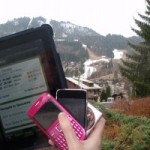May 18th, 2011Learning analytics; a grand challenge
 I recently attended Alpine Rendez-Vous 2011, meeting people from all over Europe with an interest in technology-enhanced learning (TEL). For most of the time, we were split into eight workshops – my group was exploring ‘Methods and models of next-generation technology enhanced learning‘, examining the roles of assessment and evaluation in learning.
I recently attended Alpine Rendez-Vous 2011, meeting people from all over Europe with an interest in technology-enhanced learning (TEL). For most of the time, we were split into eight workshops – my group was exploring ‘Methods and models of next-generation technology enhanced learning‘, examining the roles of assessment and evaluation in learning.
A focus for the workshop was to identify the ‘Grand Challenges’ for future research – constructing a framework for the development of TEL over the next ten years. The ideas were wide-ranging and exciting, for example: Develop new technology to harness the power of emotions for learning. One challenge was closely related to our work at SocialLearn on learning analytics and recommendations engines: ‘How can learning be assessed in an open, social TEL environment?’
Our current model for the assessment of learning is primarily summative and individual, firmly bound to hierarchical education structures. It is a model that was developed for use when educational technology had only just moved beyond the horn book, knowledge was not abundantly available, groups of learners were taught and examined at the same time in the same physical location, teachers and learners were clearly differentiated and online collaboration and publication were undreamed-of possibilities. As new models of learning have been widely adopted, this model of assessment is no longer fit for purpose. We need new approaches and new models.
Open, social TEL environments have made new models of learning possible. Learners now draw upon many different people and resources, knowledge is dispersed and distributed, individuals may move rapidly between the roles of teacher and learner, and their collaborations extend across time and space. Despite these changes, the group work, the growing archives of activity and the available data about learning networks, there is still a focus on summative assessment of individuals.
TEL environments offer learners and educators a wealth of new resources in the form of the data they record – learners’ demographics, activities, interactions, participation and engagement – but little of this is currently harnessed to support assessment and even less is used to provide formative feedback and to help learners develop their metacognitive skills, their learning dialogue, their skill-sets or their knowledge.
Colleges and universities are beginning to make use of this data, but educational data mining and analytics are often viewed from an institutional point of view – how can we recruit more students? how can we retain students for longer? how can this institution maximise its income? A wordsearch for ‘teaching’ or ‘learning’ in the current literature produces woefully limited results.
Our challenge is to make use of new resources and technologies to develop and build on learning analytics – analytics that can make a real difference for learners, producing measurable improvements in areas such as:
- Engagement with learning – supported by appropriate and personalised feedback
- Quality of online learning dialogue
- Engagement with online learning networks
- Enjoyment – due, in part, to development of a students-in-trouble alerting system
- Learners’ and teachers’ awareness of the value of learning analytics and recommendations.

June 22nd, 2011 at 12:46 pm
It is common for on-liners to visualize the connections to make such an analysis. However, in my research I used a classroom network for collective learning to visualize the diversity of group-situated perspectives, rather than the connections. Connections say something but not as much as the shared and group-situated meaning does when it is visualized from dialogue.
So, my approach to social analytics has been the co-construction and visualization of group-situated knowledge in the classroom (I think I noted that you felt that was too complex compared to doing it online?). 😉
That collective level, when captured by the technology (done automatically), gives you a new landscape for social analytics because you can group the visuals in all manner of different ways. You can even organize that to be done on online (as I have in my research).
So, rather than running a social analysis of learning online you can do it the other way round – start in the classroom. We’ve done it with up to 350 in a session. Then you can move it online or anywhere.
More importantly, you would then have a process that addresses the criteria you set out to measure change, demographics, participation etc etc. I developed this myself for my phd and I’m just completing it with Glasgow. I think my work provides a solution, albeit in a particular/creative way, to exactly the issues you raised – and some more too!
Nick Bowskill
Faculty of Education
University of Glasgow
Shared Thinking – Empathic Pedagogy for Groups
http://sharedthinking.info